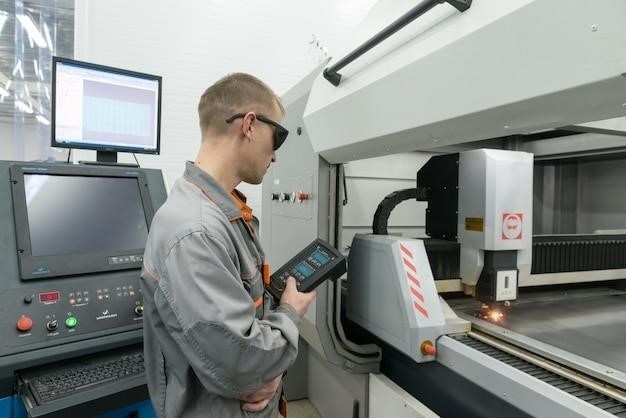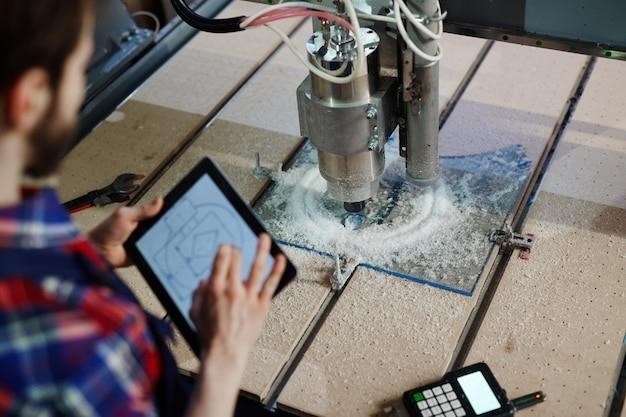CNC Machine Manuals⁚ A Comprehensive Guide
This guide explores the world of CNC machine manuals, crucial resources for operators and programmers. We cover various manual types, access methods, and essential component understanding. Learn to navigate these manuals effectively for optimal machine utilization and maintenance.
Types of CNC Machine Manuals
CNC machine manuals come in various forms, each serving a specific purpose. Operator’s manuals provide step-by-step instructions for daily operation, including safety procedures, startup sequences, and basic troubleshooting. Programming manuals delve into the intricacies of G-code and other programming languages used to control the machine, detailing syntax, commands, and advanced techniques. Maintenance manuals are essential for preventative maintenance and repair, outlining schedules, procedures, and component specifications. Installation manuals guide the setup process, ensuring proper placement, connection, and initial configuration. Specialized manuals may also exist for specific machine features or control systems, offering detailed guidance on their use and optimization. Finally, some manufacturers provide interactive digital manuals, offering enhanced search capabilities and 3D models for easier understanding. Choosing the right manual depends on your specific needs and skill level.
Accessing and Downloading Manuals
Locating and downloading CNC machine manuals often begins with the manufacturer’s website. Many manufacturers offer comprehensive online libraries containing manuals for their entire product line, often searchable by model number or serial number. These digital manuals are usually available as PDF downloads, allowing for easy access and printing. If the manufacturer’s website proves insufficient, consider contacting the manufacturer’s support directly; they can often provide manuals or direct you to authorized distributors. Online marketplaces like eBay or specialized CNC forums may offer used manuals, but caution is advised to verify authenticity and completeness. Remember to always check the version number to ensure compatibility with your specific machine. Some third-party websites aggregate CNC manuals, but ensure their legitimacy and security before downloading anything. Always prioritize obtaining manuals from trusted sources to avoid malware or outdated information. Properly maintaining your manual is crucial; store it digitally and/or physically in a safe, accessible location.
Understanding CNC Machine Components
CNC machine manuals frequently detail the machine’s core components. The bed, a robust steel frame, forms the foundation, often incorporating a T-slot table for secure workpiece clamping. The spindle, a high-speed rotating component, holds the cutting tool and is crucial for material removal. Its speed and feed rate are precisely controlled through the CNC program. Linear axes (X, Y, Z) control the tool’s movement in three dimensions, while rotary axes (A, B, C) allow for additional rotational control, depending on the machine’s configuration. The control unit, the machine’s “brain,” interprets G-code instructions, managing the intricate movements and actions of the various components. Coolant systems, crucial for lubrication and chip removal, are also described, ensuring efficient machining; Safety features, including emergency stops and guarding mechanisms, are essential components detailed for operator safety. Understanding these components is paramount for both operation and maintenance; manuals provide detailed diagrams and explanations to aid comprehension.

Manual vs. CNC Machining
This section contrasts manual and CNC machining methods, highlighting their respective advantages and disadvantages regarding precision, speed, cost, and complexity of parts produced. The choice depends heavily on project requirements.
Advantages and Disadvantages of Manual Machining
Manual machining, employing hand-operated tools and machines, offers several key advantages. Firstly, it’s significantly more affordable upfront, requiring less capital investment in sophisticated equipment compared to CNC machining. This makes it an attractive option for smaller businesses or those starting out. The lower initial cost also translates to potentially lower operating costs, especially for smaller production runs. Furthermore, manual machining provides greater flexibility for one-off jobs or small batches, allowing for quick adjustments and modifications during the process. The operator has direct control and can adapt to unexpected issues with ease.
However, manual machining also has limitations. Precision and repeatability can suffer due to human error and physical limitations. Achieving high levels of accuracy consistently requires significant skill and experience from the machinist. Production speed is considerably slower than with CNC machines, leading to longer lead times and potentially higher labor costs for larger projects. Intricate designs and complex geometries can also prove challenging and time-consuming to produce manually, limiting the scope of possible projects. The dependence on skilled labor means that production can be affected by availability and workforce fluctuations.
Advantages and Disadvantages of CNC Machining
CNC machining, utilizing computer numerical control, presents numerous advantages. High precision and repeatability are paramount, ensuring consistent quality across large production runs. Complex geometries and intricate designs are easily handled, opening up possibilities for intricate parts beyond the capabilities of manual methods. Furthermore, CNC machining significantly boosts production speed, leading to faster turnaround times and increased output. This efficiency translates to cost savings for large-scale projects, offsetting the higher initial investment in equipment. Automated processes minimize human error, reducing waste and improving overall efficiency. The ability to program and automate complex tasks also allows for unattended operation during certain phases.
Despite its strengths, CNC machining has disadvantages. The substantial initial investment in equipment is a major hurdle for smaller businesses. Programming and setup can be time-consuming and require specialized skills, increasing the need for skilled technicians. The inflexibility of CNC machines makes them less suitable for small batch or one-off projects where quick adaptations are crucial. Unexpected issues or programming errors can lead to significant downtime and potential material waste. Repair and maintenance costs can also be substantial, requiring specific expertise and potentially specialized parts. The automated nature can limit the ability to quickly adapt to unexpected variations in material properties or workpiece conditions.

CNC Programming and Operation
This section details CNC programming basics, focusing on G-code and its application. We’ll guide you through the step-by-step process of operating a CNC machine, ensuring safe and efficient machining practices.
G-Code and CNC Programming Basics
G-code forms the language of CNC machines, a set of instructions dictating tool movements and machine functions. Understanding G-code is paramount for effective CNC operation. This section delves into the fundamental commands and syntax, enabling you to create simple programs. We’ll cover preparatory commands (G-codes), defining the coordinate system, specifying feed rates (F), spindle speeds (S), and tool selection (T). Learning to interpret and write G-code empowers you to control the CNC machine precisely. Mastering the basics allows for efficient creation of programs for various machining operations, from simple milling to complex 3D sculpting. Resources such as online tutorials and reference manuals can aid in deepening your understanding of G-code’s nuances and advanced applications. Remember, practice is key to proficiency; start with basic programs and gradually progress to more complex ones. The ability to write and interpret G-code is a valuable skill in the field of CNC machining, opening doors to a wide array of possibilities in manufacturing and design. Accurate G-code programming ensures smooth and precise operation of your CNC machine, leading to high-quality results.
Operating a CNC Machine⁚ A Step-by-Step Guide
Operating a CNC machine involves a structured process. First, ensure the machine is properly set up and the workpiece is securely clamped. Next, load the G-code program into the machine’s controller. Verify the program’s accuracy and simulate the run if possible to avoid errors. Then, initiate the machining process, monitoring the machine for any unusual sounds or vibrations. Regularly check the tool condition and workpiece progress. Always adhere to safety procedures, wearing appropriate personal protective equipment (PPE). For beginners, practice on scrap material before working on valuable pieces. Careful attention to detail is vital; even minor programming errors can lead to significant problems. Understand the machine’s emergency stop procedures. Consistent maintenance is crucial to prevent malfunctions and ensure accuracy. Familiarize yourself with the specific instructions in your CNC machine’s manual. Regularly inspect the machine’s components to ensure everything is functioning as expected. The steps involved in operating a CNC machine may vary depending on the specific model and software, so always refer to the machine’s user manual for detailed instructions and safety precautions.
